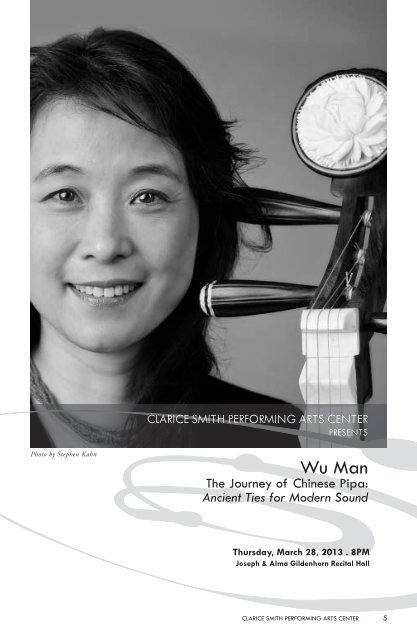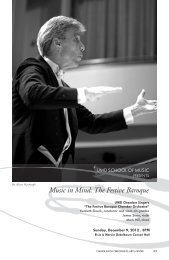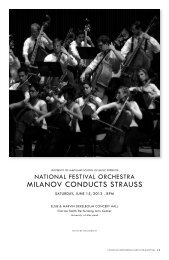Download Now (PDF) - Clarice Smith Performing Arts Center
Download Now (PDF) - Clarice Smith Performing Arts Center
Download Now (PDF) - Clarice Smith Performing Arts Center
You also want an ePaper? Increase the reach of your titles
YUMPU automatically turns print PDFs into web optimized ePapers that Google loves.
Photo by Stephen Kahn<br />
CLARICE SMITH PERFORMING ARTS CENTER<br />
PRESENTS<br />
Wu Man<br />
The Journey of Chinese Pipa:<br />
Ancient Ties for Modern Sound<br />
Thursday, March 28, 2013 . 8PM<br />
Joseph & Alma Gildenhorn Recital Hall<br />
CLARICE SMITH PERFORMING ARTS CENTER 5
PROGRAM<br />
Wu Man<br />
The Journey of Chinese Pipa: Ancient Ties for Modern Sound<br />
Xi Yang Xiao Gu (Flute and Drum Music at Sunset)<br />
Classical (Civil)<br />
The Sound of Bells and Drums from a Distant Temple along the River<br />
Moon on the Eastern Mountain<br />
Breeze over the Quiet Water<br />
Shadows of Flowers<br />
Clouds and Water Far Away Become as One<br />
A Fishman’s Song in the Evening<br />
Waves Lapping at the Shore<br />
The Returning Boat<br />
Shi Mian Mai Fu (Ambush Laid on Ten Sides)<br />
Classical (Martial)<br />
Xu Lai (Meditation)<br />
Liu Tianhua<br />
Kazakh küi<br />
Traditional<br />
arr. Wu Man<br />
Dance of the Yi People<br />
Wang Huiran (b.1935)<br />
San Liu (Three Six)<br />
Traditional<br />
Night Thoughts<br />
Wu Man<br />
Leaves Flying in Autumn<br />
Wu Man<br />
Approximately 90 minutes with no intermission.<br />
This performance is included in Diversity Through Music, an event series sponsored by the<br />
UMD Office of Diversity Education and Compliance and the Nyumburu Cultural <strong>Center</strong> through<br />
a grant from the Office of Diversity and Inclusion with the cooperation of the <strong>Clarice</strong> <strong>Smith</strong> <strong>Center</strong>.<br />
To view a full schedule of events, visit the Nyumburu Cultural <strong>Center</strong>’s website.<br />
Wu Man most recently appeared at the <strong>Center</strong> in A Chinese Home with<br />
Kronos Quartet (2009-2010).<br />
claricesmithcenter.umd.edu | 301.405.ARTS (2787)<br />
PROGRAM NOTES<br />
Musical America’s 2013 Instrumentalist of the Year and GRAMMY Award-nominated<br />
artist Wu Man is recognized as both a virtuoso and ambassador of the pipa, or Chinese<br />
lute, which has a history of more than two thousand years. Her creativity and curiosity has<br />
led to collaborations with some of the world’s leading contemporary composers such as<br />
Tan Dun, Philip Glass, the late Lou Harrison, Terry Riley, Bright Sheng, Chen Yi and<br />
many others. She also frequently performs as a member of the Silk Road Ensemble with<br />
cellist Yo-Yo Ma, and with the Kronos Quartet.<br />
Wu Man has spent the majority of her career tracing the history of her instrument<br />
throughout her native China and into Central Asia. Gramophone magazine stated, “A onewoman<br />
force of nature, she is a key figure not only for bringing Chinese traditional music<br />
to new audiences, but in becoming a muse for all manner of contemporary composers.”<br />
While documenting hundreds of journeys and adventures to little-known regions of<br />
Asia, Wu Man unearthed ancient musical traditions that have influenced both the pipa’s<br />
repertoire and Wu Man’s own technique. In this program including selections from her<br />
recordings Wu Man and Friends, Immeasurable Light and her most recent album<br />
Borderlands, Wu Man takes the audience on an illuminating and deeply personal journey<br />
of how the pipa’s story has shaped her own.<br />
Xi Yang Xiao Gu (Flute and Drum Music at Sunset)<br />
Classical (Civil)<br />
A hand-written score for this pipa piece first appeared in 1875 as a piece with seven<br />
untitled sections. It was later discovered with subtitles among Chen Zijing’s hand-written<br />
collection of pipa music in 1898. The present score, having eight sections with subtitles, is<br />
taken from Li Fangyuan’s New Collections, 1895. This composition is of the “civil” style<br />
of pipa music.<br />
Shi Mian Mai Fu (Ambush Laid on Ten Sides)<br />
Classical (Martial)<br />
Perhaps the best known of all traditional pipa works, this is a grand opus of the “martial”<br />
school of pipa music. A hand-written score for pipa solo first appeared in 1875. Structured<br />
in traditional story-telling form, “Shi Mian Mai Fu” portrays the epic battle between the<br />
kingdoms of Han (Liu Bang) and the warlord of Chu (Xiang Yu) in 202 BC. The Han<br />
army ambushed the Chu army on ten sides and finally defeated the powerful Chu (Xiang<br />
Yu committed suicide), leading to the establishment of the Han Dynasty. The music<br />
describes how the armies set up camp, effected the ambush and fought fiercely. In it can<br />
be heard the war drums, booming guns, soldiers and horses, and the shouting of soldiers<br />
at the massacre. The victors return to camp in triumph at the end of a stirring battle.<br />
Variations on a theme make use of tonal colors and timbres created by various fingering<br />
techniques to evoke a range of moods, heroism, stoicism, despair and tragedy.<br />
Xu Lai (Meditation) (1929)<br />
Liu Tianhua<br />
Liu Tianhua was a 20th-century intellectual, composer and musician who tried to<br />
formalize and modernize the study and performance of traditional Chinese music,<br />
sometimes with ideas borrowed from the West. In this work, the music conjures up the<br />
image of a person seated by a window, in the emptiness and stillness of the night,<br />
lost in meditation.<br />
WU MAN The Journey of Chinese Pipa: Ancient Ties for Modern Sound 7
PROGRAM NOTES<br />
Kazakh küi<br />
Traditional, arr. Wu Man<br />
Wu Man made this arrangement for pipa of a Kazakh folk tune that she heard performed<br />
on the dombÿra, the two-stringed plucked lute that is widely regarded as a cultural symbol<br />
of Kazakhs. Kazakhstan shares a long border with western China, and nomadic Kazakhs<br />
have long represented an ethnic minority in China’s Xinjiang-Uyghur Autonomous<br />
Region. In Xinjiang, Kazakhs speak their own language and maintain their own musical<br />
traditions. The pipa is believed to have entered China long ago through contact between<br />
Chinese civilization and the peoples whom ancient Chinese sources described as “northern<br />
barbarians,” which is to say, nomads. By performing this virtuosic nomadic melody on the<br />
pipa, Wu Man brings her instrument full circle, back to its Central Asian origins.<br />
Dance of the Yi People (1960)<br />
Wang Huiran (b.1935)<br />
This is one of the signature pieces in the repertoire of Wu Man. Wang arranged this<br />
wonderful piece in 1960 based on folk tunes of the Yi minority people, who live in<br />
southwestern China. However, the piece did not gain popularity during the Cultural<br />
Revolution (1966 to 1976) because the music evokes intoxicating nights on a<br />
mountainside and the joyous gathering of young people with lively dancing, and has<br />
nothing to do with the “Red Revolution,” which was necessary to be approved by censors<br />
at the time. Wu Man selected this piece for her audition to enter the Conservatory in<br />
Beijing in 1978 and won first place. Her performance of the piece was recorded and<br />
broadcast throughout the nation. Since then, it has become one of the most popular pieces<br />
in the pipa repertoire. This is the first pipa composition to incorporate the Western A-B-A<br />
structure, adopt Western chords and guitar techniques, and display virtuoso pipa<br />
techniques such as tremolos, strumming, sliding notes and harmonics.<br />
San Liu (Three Six)<br />
Traditional<br />
This is a popular folk tune from the Shanghai area, often played with a small ensemble<br />
at a tea house.<br />
Night Thoughts (2005)<br />
Wu Man<br />
The piece was inspired by a 9th-century Buddhist pipa tune and represented for Wu Man<br />
a chance to rediscover the pipa’s native, regional language. The piece is particularly drawn<br />
to its ancient-tune scale, which is very different from today’s mostly pentatonic pipa music,<br />
and to the peaceful, meditative sound of the pipa in the low register.<br />
Leaves Flying in Autumn (2000)<br />
Wu Man<br />
Wu Man composed this improvisational collage a few years ago with inspiration from<br />
the classical martial style of pipa works and a nod to rock ’n’ roll.<br />
ABOUT THE ARTIST<br />
Recognized as the world’s premier pipa virtuoso and leading ambassador of Chinese<br />
music, GRAMMY Award-nominated musician Wu Man has carved out a career as<br />
a composer, soloist and educator giving her lute-like instrument — which has a history<br />
of more than 2,000 years in China — a new role in both traditional and contemporary<br />
music. Through numerous trips to her native China, Wu Man has premiered hundreds<br />
of new works for the pipa, while spearheading multimedia projects to both preserve and<br />
create awareness of China’s ancient musical traditions. Collaborations across artistic<br />
disciplines have allowed Wu Man to reach wider audiences as she works to break through<br />
cultural and musical borders. On December 6, 2012 Wu Man was named Musical<br />
America’s 2013 Instrumentalist of the Year, the first traditional musician ever to receive<br />
this prestigious award.<br />
During the 2012-13 season Wu Man will tour for solo recitals across the United<br />
States and will continue to tour with the Silk Road Ensemble. She will premiere her new<br />
composition “Blue and Green” during a nine-city United States tour with New York<br />
City’s The Knights. Wu Man will also perform at the 2013 Auckland <strong>Arts</strong> Festival in<br />
New Zealand both in a solo recital and together with the Kronos Quartet in a performance<br />
of A Chinese Home, a work commissioned by the <strong>Clarice</strong> <strong>Smith</strong> <strong>Performing</strong> <strong>Arts</strong> <strong>Center</strong>.<br />
Wu Man’s latest album Borderlands was released by <strong>Smith</strong>sonian Folkways in May 2012,<br />
and her documentary Discovering a Musical Heartland: Wu Man’s Return to China was<br />
released in September of the same year.<br />
claricesmithcenter.umd.edu | 301.405.ARTS (2787) WU MAN The Journey of Chinese Pipa: Ancient Ties for Modern Sound 9




